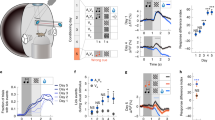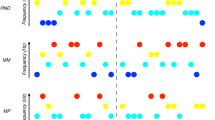Abstract
Using multivariate pattern analysis of functional magnetic resonance imaging data, we found that the subjective experience of sound, in the absence of auditory stimulation, was associated with content-specific activity in early auditory cortices in humans. As subjects viewed sound-implying, but silent, visual stimuli, activity in auditory cortex differentiated among sounds related to various animals, musical instruments and objects. These results support the idea that early sensory cortex activity reflects perceptual experience, rather than sensory stimulation alone.
This is a preview of subscription content, access via your institution
Access options
Subscribe to this journal
Receive 12 print issues and online access
$209.00 per year
only $17.42 per issue
Buy this article
- Purchase on Springer Link
- Instant access to full article PDF
Prices may be subject to local taxes which are calculated during checkout



Similar content being viewed by others
References
Formisano, E., De Martino, F., Bonte, M. & Goebel, R. Science 322, 970–973 (2008).
Staeren, N., Renvall, H., De Martino, F., Goebel, R. & Formisano, E. Curr. Biol. 19, 498–502 (2009).
Macknik, S.L. & Haglund, M.M. Proc. Natl. Acad. Sci. USA 96, 15208–15210 (1999).
Watkins, S., Shams, L., Tanaka, S., Haynes, J.-D. & Rees, G. Neuroimage 31, 1247–1256 (2006).
Chen, L.M., Friedman, R.M. & Roe, A.W. Science 302, 881–885 (2003).
Blankenburg, F., Ruff, C.C., Deichmann, R., Rees, G. & Driver, J. PLoS Biol. 4, e69 (2006).
Kosslyn, S.M., Thompson, W.L., Kim, I.J. & Alpert, N.M. Nature 378, 496–498 (1995).
Slotnick, S.D., Thompson, W.L. & Kosslyn, S.M. Cereb. Cortex 15, 1570–1583 (2005).
Thirion, B. et al. Neuroimage 33, 1104–1116 (2006).
Serences, J.T., Ester, E.F., Vogel, E.K. & Awh, E. Psychol. Sci. 20, 207–214 (2009).
Harrison, S.A. & Tong, F. Nature 458, 632–635 (2009).
Zatorre, R.J. & Halpern, A.R. Neuron 47, 9–12 (2005).
Kraemer, D.J.M., Macrae, C.N., Green, A.E. & Kelley, W.M. Nature 434, 158 (2005).
Dierks, T. et al. Neuron 22, 615–621 (1999).
Calvert, G.A. et al. Science 276, 593–596 (1997).
Acknowledgements
H.D. and A.D. are supported by the Mathers Foundation and the US National Institutes of Health (5P50NS019632-25).
Author information
Authors and Affiliations
Contributions
K.M. conceived and designed the study with input from the other authors, conducted functional magnetic resonance imaging (fMRI), participated in data analysis and wrote the manuscript together with A.D. J.T.K. advised on study design, conducted fMRI, performed the data analysis and wrote part of the supplementary information. R.E. prepared stimuli, wrote the stimulus presentation script, conducted fMRI, traced anatomical masks, participated in data analysis and conducted literature review. C.W. prepared stimuli, traced anatomical masks and conducted literature review. H.D. supervised the design of the anatomical masks and provided conceptual advice. A.D. supervised the project and advised K.M. on the preparation of the manuscript. All authors discussed the results and their implications and commented on the study and manuscript preparation at all stages.
Corresponding author
Ethics declarations
Competing interests
The authors declare no competing financial interests.
Supplementary information
Supplementary Text and Figures
Supplementary Figures 1–8, Supplementary Methods, Supplementary Results and Supplementary Discussion (PDF 668 kb)
Supplementary Video 1
This clip displays a howling dog and serves as an example for the animal video clips. (MOV 1639 kb)
Supplementary Video 2
This clip displays a piano key being struck and serves as an example for the musical instrument video clips. (MOV 1273 kb)
Supplementary Video 3
This clip displays a handful of coins being dropped into a glass and serves as an example for the object video clips. (MOV 1231 kb)
Rights and permissions
About this article
Cite this article
Meyer, K., Kaplan, J., Essex, R. et al. Predicting visual stimuli on the basis of activity in auditory cortices. Nat Neurosci 13, 667–668 (2010). https://doi.org/10.1038/nn.2533
Received:
Accepted:
Published:
Issue Date:
DOI: https://doi.org/10.1038/nn.2533
This article is cited by
-
Event-related functional MRI of awake behaving pigeons at 7T
Nature Communications (2020)
-
Cross-modal representations in early visual and auditory cortices revealed by multi-voxel pattern analysis
Brain Imaging and Behavior (2020)
-
Primary sensory cortices contain distinguishable spatial patterns of activity for each sense
Nature Communications (2013)
-
Recent developments in multivariate pattern analysis for functional MRI
Neuroscience Bulletin (2012)
-
Decoding brain states using functional magnetic resonance imaging
Biomedical Engineering Letters (2011)



